We’ll assume - Study guides, Class notes & Summaries
Looking for the best study guides, study notes and summaries about We’ll assume? On this page you'll find 82 study documents about We’ll assume.
All 82 results
Sort by
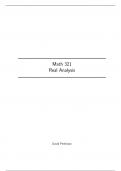
-
Math 321 Real Analysis
- Exam (elaborations) • 81 pages • 2024
-
- $18.59
- + learn more
Metric Spaces 1. Equivalence Relations Definition 1.1. A relation on a set S is a subset R ⊆ S × S. If (a, b) ∈ R, we write a ∼R b (or just a ∼ b). Example 1.2. (1) Let S be the set of members of our class, and let (a, b) ∈ R if person a is shorter than person b. (2) Let S = Z and R = {(a, b) ∈ Z | b = 2a}. Thus, 4 ∼ 8 and 8 ∼ 16. Definition 1.3. A relation ∼ on a set S is an equivalence relation if for all a, b, c ∈ S, (1) a ∼ a (reflexivity) (2) a ∼ b =⇒ b ...
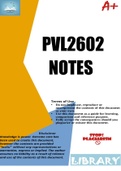
-
PVL2602 Semester 1 Notes
- Summary • 24 pages • 2023
-
- $2.85
- 1x sold
- + learn more
Succession Succession: - This aspect of law deals with what happens to an estate (the assets you leave behind) after you pass away. - Estate = the assets, obligations, liabilities, debts, etc. that you leave behind. - Inheritance = what is left once all the debts and liabilities have been paid. - Succession determines who qualifies to inherit. There are 2 types of succession: - 1) Testate = dealing with wills. - 2) Intestate = dealing with no wills. Terminology: - Deceased = person w...
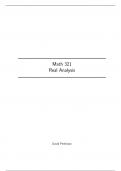
-
Math 321 Real Analysis
- Exam (elaborations) • 81 pages • 2024
-
- $18.99
- + learn more
Metric Spaces 1. Equivalence Relations Definition 1.1. A relation on a set S is a subset R ⊆ S × S. If (a, b) ∈ R, we write a ∼R b (or just a ∼ b). Example 1.2. (1) Let S be the set of members of our class, and let (a, b) ∈ R if person a is shorter than person b. (2) Let S = Z and R = {(a, b) ∈ Z | b = 2a}. Thus, 4 ∼ 8 and 8 ∼ 16. Definition 1.3. A relation ∼ on a set S is an equivalence relation if for all a, b, c ∈ S, (1) a ∼ a (reflexivity) (2) a ∼ b =⇒ b ...

-
CS 234 assignment 2 Updated-ALL ANSWERS 100% CORRECT Study Guide
- Exam (elaborations) • 12 pages • 2022
-
- $6.99
- 4x sold
- + learn more
CS 234 Winter 2022: Assignment #2 Introduction In this assignment we will implement deep Q-learning, following DeepMind’s paper ([1] and [2]) that learns to play Atari games from raw pixels. The purpose is to demonstrate the effectiveness of deep neural networks as well as some of the techniques used in practice to stabilize training and achieve better performance. In the process, you’ll become familiar with PyTorch. We will train our networks on the Pong-v0 environment from OpenAI g...
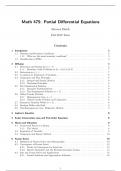
-
Math 475: Partial Differential Equations
- Exam (elaborations) • 19 pages • 2023
-
- $18.79
- + learn more
Math 475: Partial Differential Equations Shereen Elaidi Fall 2019 Term Contents 1 Introduction 2 1.1 Domains and Boundary Conditions . . . . . . . . . . . . . . . . . . . . . . . . . . . . . 3 1.1.1 What are the main boundary conditions? . . . . . . . . . . . . . . . . . . . . . 3 1.2 Classification of PDEs . . . . . . . . . . . . . . . . . . . . . . . . . . . . . . . . . . . . 3 2 Diffusion 4 2.1 Derivation and Setting Up (n = 1) . . . . . . . . . . . . . . . . . . . . . . . . . . . . ...
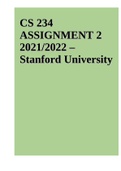
-
CS 234 ASSIGNMENT 2 2021/2022 – Stanford University
- Exam (elaborations) • 13 pages • 2022
-
- $8.49
- 2x sold
- + learn more
CS 234 ASSIGNMENT 2 2021/2022 – Stanford University. Distributions induced by a policy (13 pts) In this problem, we’ll work with an infinite-horizon MDP M = hS, A, R, T , γi and consider stochastic policies of the form π : S → ∆(A) 1 . Additionally, we’ll assume that M has a single, fixed starting state s 0 ∈ S for simplicity. (a) (written, 3 pts) Consider a fixed stochastic policy and imagine running several rollouts of this policy within the environment. Naturally, depe...

-
C How To Program, 8th Edition By Deitel & deitel - Test Bank
- Exam (elaborations) • 209 pages • 2023
-
- $23.86
- + learn more
3.1 Introduction (No Questions) 3.2 Algorithms 3.1 Specifying the order in which statements are to be executed in a computer program is called (a) an algorithm (b) transfer of control (c) program control (d) pseudocode ANS: (c) 3.2. The two key attributes of an algorithm are: a) actions and start activity b) flow and order of flow c) actions and order of actions d) flow and start activity ANS: (c) 3.3 Pseudocode 3.3 Which of the following is true of pseudocode programs? ...
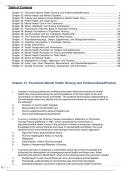
-
Test Bank Psychiatric Nursing Contemporary Practice (6th Edition by Boyd)
- Exam (elaborations) • 143 pages • 2024
-
- $15.49
- + learn more
Test Bank Psychiatric Nursing Contemporary Practice (6th Edition by Boyd)Table of Contents Chapter 01: Psychiatric-Mental Health Nursing and Evidence-Based Practice .............................................. 1 Chapter 02: Mental Health and Mental Disorders .......................................................................................... 4 Chapter 03: Cultural and Spiritual Issues Related to Mental Health Care ..................................................... 8 Chapter 04: Patie...

-
CS 234 ASSIGNMENT 2 2021/2022.
- Exam (elaborations) • 13 pages • 2022
-
- $5.49
- 1x sold
- + learn more
CS 234 ASSIGNMENT 2 2021/2022.0 Distributions induced by a policy (13 pts) In this problem, we’ll work with an infinite-horizon MDP M = hS, A, R, T , γi and consider stochastic policies of the form π : S → ∆(A) 1 . Additionally, we’ll assume that M has a single, fixed starting state s 0 ∈ S for simplicity. (a) (written, 3 pts) Consider a fixed stochastic policy and imagine running several rollouts of this policy within the environment. Naturally, depending on the stochastici...
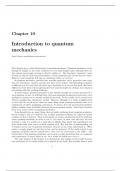
-
In this section we’ll give a “derivation” of the Schrodinger equation. Our starting point will be the classical nonrelativistic expression for the energy of a particle, which is the sum of the kinetic and potential energies. We’ll assume as usual that the
- Exam (elaborations) • 20 pages • 2024
-
Available in package deal
-
- $7.99
- + learn more
In this section we’ll give a “derivation” of the Schrodinger equation. Our starting point will be the classical nonrelativistic expression for the energy of a particle, which is the sum of the kinetic and potential energies. We’ll assume as usual that the potential is a function of only x. We have E = K + V = 1 2 mv2 + V (x) = p 2 2m + V (x). (3) We’ll now invoke de Broglie’s claim that all particles can be represented as waves with frequency ω and wavenumber k, and that...

How much did you already spend on Stuvia? Imagine there are plenty more of you out there paying for study notes, but this time YOU are the seller. Ka-ching! Discover all about earning on Stuvia


